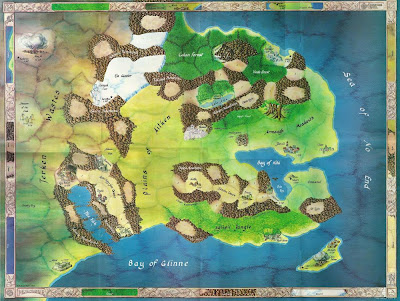 |
| Map by Erin McKee |
In 1983, Dave Arneson's Adventure Games released Pentantastar, “A Fantasy Boardgame of Magic and Strategy.” It was designed by Dave Megarry (one of the designers of Dungeon!) and his family. Playtesters included Arneson himself, Richard Snider (Arneson's Adventures in Fantasy collaborator and Powers & Perils designer), Scott Bizar of Fantasy Games Unlimited, and Dave Wesely.
The game is about a conflict between two factions in a fantasy setting. The factions are not labeled as 'good' or 'evil'. However, one may infer that the West – ruled by the mysterious Arkhon™ – is the 'bad' side since it is the aggressor and has trolls.
The game has two aspects: military and quest. In the military aspect, counters (called 'pieces') represent armies and other forces. The combat strength of pieces in conflict are compared. If the attacker's combined combat strength is equal to or less than the defender's, nothing happens. If the attacker's strength exceeds the defender's, the defender's pieces retreat or are removed from the game. There are certain key locations, the East has four and the West has three. A military victory is achieved when one side occupies all key locations of the opposing side.
In the quest aspect, the Eastern operatives (a pair of wizard siblings) vie against the Western operative (a wolf) to collect five 'charms'. When the charms are assembled, they form the titular Pentantastar™. A magical victory is achieved when one side brings the Pentantastar to the opposing side's capital. Each charm activates certain creatures:
- Liths™ – living rocks
- Serak™ – “spiked clusters of ice about the size of a man's head and shaped like puffed-out dandelions”
- Sletta™ – bog creatures
- Antherb™ – huge vines that are “literally several places at once”
- Quila – wyvern-like creatures (I would have called them 'wyverns')
- Vorts™ – “black, scaly” snakes with lethal poison; they “have heads mantled with a fan of red and silver”
There is a booklet with seven pages of rules and one page with instructions on how to make your very own Pentantastar using paper clips and plastic straws. There is a separate booklet with seven pages of background fiction and a seven stanza poem/prophecy.
Each side has a deck of cards from which a hand of five cards is drawn every round. Each card has a military function and a quest function, but only one function can be used when played. The quest function for each card is represented by a number of 'magic points'. Every round, both players 'spend' cards for magic points. The player with more magic points (including those available from certain pieces and from occupying certain spaces) moves the quest operatives. The military function for a card is either a 'mobilization' (introducing new pieces) or a 'hazard' (inflicting obstacles like storms). Quest pieces are unaffected by hazards or military actions.
I think I would have designed it so that each charm would not activate special creatures. Instead, the winner of the magic point bid for the round could cast a spell based upon which charms had been recovered. For instance, the white charm could prevent some pieces from attacking, the yellow charm could negate a hazard, etc. Also, I would not have used funky, 'trademarked' creatures; just traditional creatures with which anyone likely to play the game would be familiar.
Anyway, I can easily imagine the questing wizards – Seraphael and Waalibor – and their gypsy friend, Wandelar, as player characters in a campaign against a backdrop of war and intrigue.
 |
| Art by Erin McKee |
Vorts....how the heck do I remeber vorts...I never played or saw this game ?
ReplyDelete